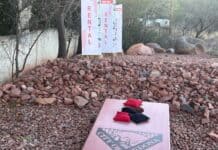Nearly four months after #PoopGate sent the Northern Arizona distance running community into a frenzy, peace and order has been restored. According to Jennifer Chilton, the Sedona-Oak Creek School District director of facilities & operations, the district is renting the track at Sedona Red Rock Jr./High School to commercial and professional organizations once again.
The district now-infamously restricted track rentals to outside organizations during the spring semester. In a Feb. 10 email, initially sent as a response to a commercial usage request that Chilton later passed on to the Sedona Red Rock News, she told potential renters that the district would no longer take reservations, “at least until the student seasons end,” citing scheduling conflicts with SRRHS’s track and field practice sessions.
The district still honored reservations made before the district’s decision.
In a separate email to the Sedona Red Rock News, Chilton confirmed a rumor spreading rapidly through Twitter — that human feces was found on the premises. In the months since, the Sedona Red Rock News learned through multiple sources that human feces had indeed been found near the track in February — close to the snack bar on the south end of the stadium.
Still, Chilton insisted that the “restrictions” on track rentals wasn’t due to the fecal findings, but instead “the sheer number of professional groups and runners played a larger role” as she put it.
The district’s decision to shut down the track led to rampant online speculation, dubbed as “#PoopGate.”
Twitter users debated the district’s true reasoning to the restrictions. Flagstaff-based professional runner Rory Linkletter sent a Feb. 21 tweet saying that a “group ran through the halls” of SRRHS during school hours, prompting the restrictions, but Chilton denied any such incident ever took place.
Linkletter told the Sedona Red Rock News in a March phone interview that he still believed the restrictions were placed due to incidents stemming from professional runners, but added that his feelings were purely speculative.
The restrictions affected the careers and training schedules of Flagstaff-based runners like Linkletter. The “live high, train low” training method is vital to the success of distance runners, he said, and the sudden inaccessibility to Sedona’s track brought challenges to the community.
“[The proximity to Sedona is] a huge tool that is what actually makes Flagstaff the greatest place — maybe on Earth — but definitely in North America to train,” he told the Sedona Red Rock News in March.
Linkletter and other professional runners have been using the track at Mingus Union High School in Cottonwood as an alternative in the past few months, but that situation
was unsatisfactory to him, as the added 20 to 30 minute commute took a toll. But Linkletter and other professional runners can now return to Sedona, as long as they are approved for reservation times through Chilton and the district administration.
Chilton says rentals are allowed only if the times are scheduled when the track isn’t in use by students and if the renters follow district procedures for facility use, like proof of insurance and payment of a rental fee. The track is still open to local residents, but the district requests they use the outside lanes in order to distribute wear on the track.
